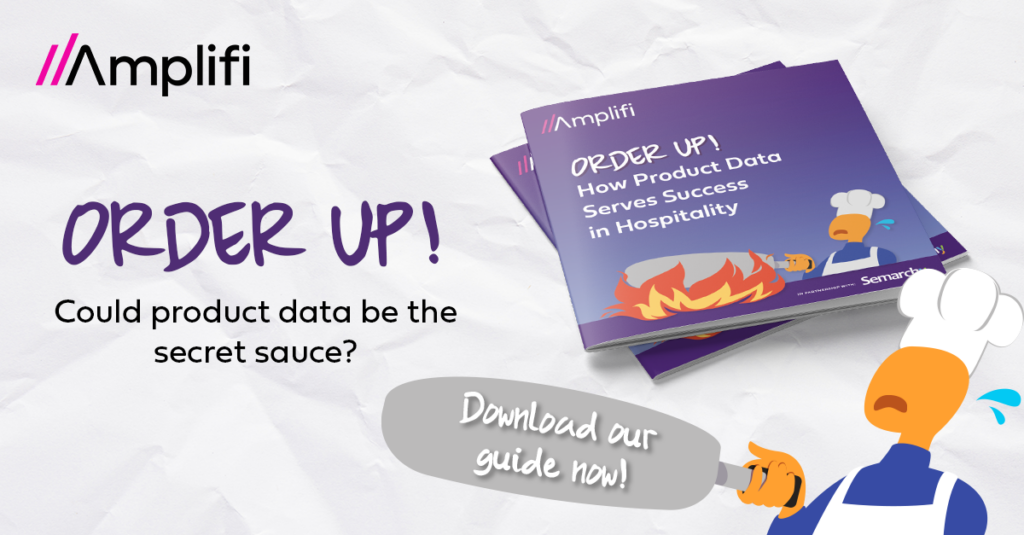As a restaurant or quick service restaurant (QSR) operator, you have a lot on your plate. From managing your supply chain to cutting costs and creating mouth-watering menus, it’s no surprise that keeping track of product data can fall by the wayside.
But did you know that inaccurate, inaccessible, or outdated product information can put your reputation and bottom line at risk? In this blog post, we’ll highlight five data risks that every restaurant and QSR should know, plus how to respond.
 Non-Compliance with Menu Labeling Laws
Non-Compliance with Menu Labeling Laws
According to Fast Casual, eating healthy is the most highly desired lifestyle change, reported by 46% of consumers. To help meet that need, the U.S. passed Menu Labeling Laws in 2018 as part of the Affordable Care Act (ACA).
The laws require chain restaurants and similar establishments with 20 or more locations to display calorie information on menus and menu boards. Other nutritional information, like carbs or sugar, must also be available upon request.
Are you currently compliant? If not, you could face fines from the Food and Drug Administration (FDA). Restaurants can avoid penalties by properly training associates, tracking nutritional data, and keeping menu information up to date.
A central source of product data—where multiple users can collaborate—is crucial to your efforts. After all, product data is the backbone of every menu and product label. Operators need easy access to accurate, consistent information to ensure compliance and meet the consumer demand for transparency.
 Supply Chain Shortages
Supply Chain Shortages
The hospitality industry continues to face supply chain shortages that negatively impact menu planning, revenue growth, and customer satisfaction. Restaurants must be able to pivot when faced with disruption — like the current drastic egg shortage or when the price of potatoes spiked 63% last year.
However, if you have outdated and siloed data, it can be difficult to quickly fill supply chain gaps. On the other hand, a central source of product data helps restaurants manage their inventories more effectively. This data should include information about suppliers, products, pricing, locations, and lead times. You can analyze and apply data insights to avoid overstocking, running out of key ingredients, or under/over-pricing your menu.
 Slow Response to Food Recalls
Slow Response to Food Recalls
Food recalls can have devastating consequences for restaurants, particularly in cases where a health risk is posed by a contaminated ingredient. Recent news stories highlight deadly recalls related to romaine lettuce, eggs, flour, and beef.
While manufacturing recalls are often out of your control, you can do plenty to respond and recover. For food and beverage establishments, most of the fallout relates to incorrect or missing information that impedes the traceability process. To respond, you need quick access to information on ingredients used within each product and meal, viewable by location.
With traceability data, you can quickly remove affected products from service and reassure your customers that it’s safe to dine with your establishment. You can also leverage product details to find and source similar items as an alternative until the recall resolves.
 Rising Costs
Rising Costs
Inflation has taken its toll on restaurant operators, who continue to feel the impact of the rising costs and labor shortages. Yet passing that burden to your guests—through “tipflation” or higher menu prices—can lead to unhappy customers.
Instead, restaurants can find opportunities to reduce costs by reviewing their data, including pricing, location, suppliers, and more. Accurate data can help restaurants minimize waste by ensuring that they source, use, ship, and store ingredients in the most cost-effective way.
For example, an Amplifi client—IPC Subway— discovered a startling link between a .5 lb. discrepancy in mayonnaise and its impact on their logistics. While building a business case for master data management (MDM), they determined that this one fix would lead to an annual cost avoidance of $1.3 million! They turned a costly risk into a savings opportunity.
 Fast Pace of Digital Expectations
Fast Pace of Digital Expectations
With the rise of mobile apps and online ordering, customers increasingly expect frictionless interaction with your brand. Lacking a strong digital presence is certainly a risk — but so is having a fragmented presence across channels.
Customers want a convenient, consistent experience, whether placing an online order, using a third-party delivery app, reviewing nutritional information, or getting details about your brand and locations.
This shift in consumer behavior presents new challenges for restaurants. Inaccurate or outdated data can result in errors on digital ordering platforms, leading to confusion and dissatisfaction. Restaurants must stay ahead of the curve by regularly updating their product data and ensuring data can flow seamlessly between channels and systems.
How Can Restaurants and QSRs Reduce the Data Risk?
Most hospitality businesses have many different types of data housed across disparate systems, such as spreadsheets, legacy ERPs, point of sale (POS) systems, and more. The data you need is often missing, hard to access, or can’t be trusted.
Perhaps the best way to reduce your data risk is to work toward a centralized and well-governed data practice. Keep in mind that implementing a data program without a sound strategy can also be risky. Any missteps could lead to greater issues and more technical debt.
So, what’s the right approach?
- First, start by aligning your data goals with your business strategy. Do this before you delve into the architecture, processes, and improvements needed to support your business.
- Once aligned with your business strategy, consider the right technology for your needs. Many restaurants and QSRs opt for a user-friendly, cloud-based MDM platform with a scalable data model that can expand gradually over time. Another benefit? Operators like the ability to build applications related to very specific data problems, like improving menu pricing based on specific locations.
- Finally, choose your first project wisely. You’ll want to select an initial use case that provides tangible value, a manageable level of change, and leads to a “quick win” — i.e., fast implementation and a rapid ROI.
We’re Here to Help
At Amplifi, we know the stakes are high — from supply chain shortages, consumer demands, ever-changing menus, food recalls, and evolving regulations. By staying on top of your product data, QSRs and restaurants can minimize these risks and even turn them into significant opportunities.
Ready to learn more? Download our guide, presented with our partner Semarchy: Order Up! How Product Data Serves Success in Hospitality


